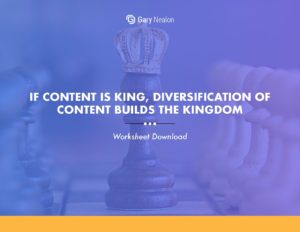Nearly two decades ago, Bill Gates proclaimed that, “Content is King.”
It’s hard to believe it, but that was in 1996. Ever since this prophetic statement, content’s been ruling the net!
But while it’s certainly true –that content is the mighty ruler of the internet, there’s one important and often-forgotten caveat: content is only king if it’s read. Otherwise, it’s a kingdom of one.
For businesses and startups today, investing in a top-notch content strategy is where it’s at. After all, an estimated 70% of your customers would rather learn about your business through an article as opposed to an advertisement.
Whether you do this yourself, our outsource it, is entirely up to you –and dependent upon a number of factors like your time, and inclination to devote time to it, but still –there are tremendous benefits to be gained from having engaging, relevant, useful, and readable content.
Or, as marketing guru and bestselling author Neil Patel puts it, “Good content should be interesting, challenging, entertaining and worthwhile. Otherwise, the producer (writer) has wasted his or her time.”
If you’re thinking about upping your content marketing strategy, you’ve come to the right place. In this guide we’ll show you what you can do to create exceptional content –the kind that’ll get noticed, and read –and generate results!
Diversification of Content: Building the Kingdom
Every time I would attend a seminar and listen to people speaking in their respective areas of expertise, one thing was mentioned almost every time: content.
I realized that although different experts all have varying opinions –about which format’s best, the underlying common denominator always was: the value of content.
It hit me that, if I were to create a piece of content –and then present the same message in a number of different forms, I would be reaching my target audience in the way that they best receive information.
In effect, this is something that we see with stories fairly often. Often a story becomes a book –and then that book becomes a movie. Later, you might see that movie turned into a TV series.
Not everyone absorbs content the same way. Some of your customers may enjoy reading blog posts, appreciating the ability to skim for key information or savor words and phrases a bit more. Others are more visual –and prefer to see the information –maybe in a YouTube or even a webinar or SlideShare format.
Some prefer audio, podcasts and the like. Others –are looking for sound bites –and prefer on-the-go information via social media.
The point is clear. When you put your content or your message into multiple formats and syndicate it, your chances of reaching a potential customer increases significantly.
In addition to sharing your content in multiple formats, you are also going to want to put it onto many different platforms.
In this guide I’ll share with you the steps that I use to originate and syndicate my content.
Brainstorming: How to Create Content
While everyone’s different, and it’s worth mentioning that some of your best ideas will come to you while you’re driving or in the shower, practically speaking –there are a number of places where you can draw inspiration for your content ideas.
Below is a list of the methods we utilize to obtain and originate content. Using these methods will give you and your team plenty of topics to cover:

Ways to Find Content Inspiration
- Questions that you receive from your customers through your customer service department can provide inspiration for content
- Objections or hurdles that your customers are facing during the sales cycle can also be covered in content
- What people are saying in your competitors’ reviews can inspire some ideas
- Reviewing your competitor’s websites and blogs can give you ideas
- Monitoring Google Trends in your niche can be a great source of inspiration
- Follow trends, topics, new, and activity in your niche (Use IFTTT)
- Set Google Alerts for relevant keywords
- Listen to podcasts in your niche

Now, let’s explore some of these ideas a bit more.
Customer Service Feedback
One excellent source for ideas is from our customers themselves.
We take every form of communication that comes into our customer service department –and then see how we can incorporate it into a form of content. Once we receive a question from a customer regardless of what it is, we record it, and look for patterns. We pay close attention to what our customers are asking, and then we take those questions and begin to form an article or post.
Objections From Potential Customers
In addition to customer service feedback, we also look at objections from potential customers.
I believe this is important because as we post content to multiple platforms, from a sales perspective, we are helping to remove some of the roadblocks that people may have to buying –before we officially engaging with them.
Competitors’ Reviews
We also analyze our competitors’ reviews. In sports, you would probably call this watching game film. I believe this is important because we can see what the competition is doing right and depending on what they are doing, we will replicate and duplicate it with our own twist. On the other hand, if they’re doing something that’s eliciting a negative response, we’ll ensure that we don’t repeat their mistakes.
Competitors’ Websites
Our goal is always to attempt to make the buying cycle as seamless as possible for the customer, so we will also review our competition’s websites. We look for things that are engaging the customer, either helping to build the brand or get them into the buying cycle.
Here are a few things we look for when reviewing a site:
- Overall design – is there anything unique that stands out to draw in the customer?
- Pop-ups – what are they saying or asking?
- What are they showing above the fold and below the fold?
- What types of offers or sales are they presenting?
- What is their call to action?
- How do they present content and what do they include?
- What sort of opt-in techniques do they utilize?
- What keywords are being used to find their site?
- Are they retargeting us, once we leave the site?
We have been able to implement many ideas from our competition as a result of this.
From a content creation point of view, we’ll also check what’s trending in their blog posts. In a unique way, your competition’s content is a great source of inspiration. Just take care that you never copy anything directly. Instead, use it to inspire your own content creation.
Once we see what competitors are writing about, we will then plug the topic into Google Trends. This allows us to look at related topics and queries, which gives us additional ideas for content. As a side note: this tool also plays a vital role in keyword selection.
Many business owners and entrepreneurs overlook the effectiveness of Google Trends. Keep in mind that Google Trends is more than just a keyword search tool.
Take some time to learn the basics or delegate someone on your staff to see how this tool can become an integral part of your marketing strategy. If you want to find out what your audience is searching for, then a solid Google Trends plan is a necessity.
One other tool that we find effective is IFTTT. This app allows you to link apps and devices. This tool allows us to easily track, say, when a competitor is promoting a sale. If they do, then we are sent an email that shows us the link to find the sale they are promoting. Also, if a new competitor comes into our category on Amazon, we can get an email letting us know, then we can analyze their processes and content.
The IFTTT actions are called recipes. Run some tests and see what your recipe for success is.
Creating and Syndicating Content: Our Process
Once you’ve creates a piece of content, you don’t have to hit publish and forget about it. There are lots of different things that you can do with it. Reuse and recycle!
Here’s a look at our process from taking content from the idea stage, on toward the finished product, and finally –turning that one piece of content into a number of different pieces.
- We organize and log questions from the customer service department
- We draft a post or article from the questions
- We then turn that article into a PDF
- That content is then transcribed into video and audio format
- The content is also turned into an Infographic
- It’s turned into a JPEG
- We also create a SlideShare (PowerPoint) for the content
- Finally, the content’s also posted on websites, blogs, and social media sites
Drafting the Original Piece of Content: Blog Posts

The majority of the time with a few exceptions, the original content will be in the form of a blog post.
We will take the information that we have compiled and write the post covering all aspects of the information we have obtained from our research.
When formatting your blog posts, keep readability and skim-ability in mind. Use bullet points, formatting, and images. Break up sentences, use terminology that makes sense, and –don’t try to be clever, use words that your audience knows.
You should also ensure that your blog posts are engaging; keep them interesting. Don’t write something that you wouldn’t want to read. Make sure they are useful and relevant, providing real value to your reader.
When we create blog posts, we’ll also usually look at the data that we’ve gathered in our research, and see if there’s anything that the competition may have overlooked. If so, we’ll make sure to include that in our content. We always want to make sure we are adding value.
Finally, always keep your goal for the content in mind. When turning a customer question into a blog post, the ultimate goal is to answer a question or address an issue so they’ll engage with us, or opt into our mailing list so we can continue to give them high-quality content in a variety of formats.
Format the Content to a PDF File
Everyone can view a PDF file, and in some cases, it’s the best way to share certain documents.
Google Docs will also allow you to download any file to a PDF format and you can save Word Docs as PDFs as well.
I would caution you on downloading any free software that will tell you that they can convert documents to PDF. Many times these programs are sub-par and contain many glitches and are not always updated to stay in alignment with your document programs. If you do select one from a search, choose wisely.
Situations where PDF format is ideal:
- When you intend for users to print content
- For long content
- For secured documents
- For downloadable content
Having a PDF also makes the content creation process easier as well, since it allows us to quickly fire off the documents to different contractors. For example, if we wanted to make an infographic of this article, the PDF file of this article would be forwarded to one of our graphic designers.
One suggestion is that if you are going to be posting content on a consistent basis, it is best to come up with a standard format and design. This will allow you to brand your content and your audience will become familiar with your style and format.
Transcribe Content to Video or Audio
In today’s market, video content is growing at an exponential rate.
Many people will want their content in a video format, a mini-series, if you will. Audio is ideal for people who are on-the-go, or those who enjoy multitasking. It’s also perfect for people that want to listen to it while utilizing their phone, laptop or any other device.
Another use of video is creating how-tos. Many of the questions that we have coming in from customers has to do with assembly and installation. To address these issues, we record tutorials right in our office and post them on YouTube.
There are many people that prefer an audio or video to articles, and you want to make sure you capture this segment of the marketplace as well.
We have also found that these short videos can be used in future podcasts, advertisements, commercials, instructional videos, or webinars. These days, it’s easy to edit and video or audio file into whatever project you’re working on.

Get our If Content is King, Diversification of Content Builds the Kingdom delivered right to your inbox.
Create an Infographic

Infographics are awesome! Featuring words, graphics, and sometimes images –they’re a useful tool for consuming a lot of information very quickly.
An infographic will allow someone to quickly get the overall theme of the content we are presenting and then be able to become more engaged in the content quickly. If a potential customer takes the time to go over an extensive infographic, we have created content that will increase the probability of pursuing the content in other formats.
There are several infographic software programs available that are reasonably priced. One popular software program is Piktochart. It’s a quality tool with a reasonable price tag. If you’re anything like most startups, and don’t have an in-house design team or the inclination to make an infographic yourself, you can easily outsource the task to a designer.
If your business is not at a stage where this is a feasible expense, don’t worry. Just focus on creating other types of high-quality content and then incorporate this format at a later date.
Put the Content Into a JPEG File
In a nutshell, JPEG is to photos what words are to PDF.
Why JPEGs? Simple. People are visual. If you’re selling a product, having lots of images will enable them to see exactly what they’re getting. The customer wants photos so as they are in the planning phases of the purchase they can easily access these photos for comparison purposes.
If you’re in a business that sells products –especially ones that involve a high number of decisions, then it’s especially important to use plenty of high-quality images. With my RTA Cabinet Store, customers need to be able to visualize their dream kitchen, and having plenty of photos helps them to do so.
Another benefit of JPGs is that it allows content to be duplicated on multiple platforms. This makes it easy to share with your marketing team, copywriters, and designers –allowing them to easily access the photos and integrate them into their content.
There are several great programs that you can download for free or purchase for a reasonable amount that will enable you to copy and convert photos to JPG files for easy distribution. These programs will allow you to pull photos off of a pdf file or collect images that are embedded in a blog.
Here are several programs that will up your JPG game:
Finally, you could always just use good ol’ MS Paint –it has an option for you to save things as JPGS.
Create a SlideShare

A PowerPoint, or LinkedIn SlideShare allows us to be able to put the content in a presentable format.
For example, a SlideShare presentation may be part of a visual for a video or can be run in the background synced to an audio recording of the content.
Often people enjoy the format of reading content via SlideShare. We will also utilize SlideShares for instructional videos or webinars, and we can also use them for live demonstrations. Using SlideShare for a podcast allows the customer not only to hear the content, but they are also able to see it.
Putting It All Together
I will be the first to admit that creating and putting a topic into just one format can be a massive undertaking. Throw in the task of creating multiple formats and it’s easy to feel overwhelmed!
If your head’s spinning, let me assure you that content creation, doesn’t have to be an all-or-nothing endeavor. The process that I’ve outlined is something that can easily be adjusted for your own needs and budget. For most startups, simply getting on a good blogging schedule, and tackling social media is the best place to start.
Then, once you start to build a team, or grow your company, creating multiple forms of content –like infographics, YouTubes, and SlideShares –may be the next step.
It has taken us months and in some cases years to get these processes in place. And even with an established system in place there are still challenges that arise to be able to streamline all of our content across multiple platforms. Don’t get discouraged. Instead, do what you can now. And do what works for you.
Eventually, you will get into a groove and have a well-oiled content machine.
When you’re ready to start diversifying your content, you will want to develop your own process that utilizes multiple sources that will automate and simplify the plan. Diversifying content requires work, delegation, and organization to work seamlessly and your best approach will usually involve utilizing a team.
Two programs that we use on a daily basis to assign tasks to our virtual assistants and other team members are Asana and Slack.

Asana is currently our primary project management software program. It allows us to easily track the progress of multiple projects taking place in various departments.

Slack is our online messaging program. It permits us to communicate with each other easily and also be able to share documents and JPG files easily.
Find decent contractors by heading over to websites that have job boards for specific industries. Find bloggers and copywriters on ProBlogger.com or find a designer on DesignJobBoards.com. Post an ad, and source from the best candidates. It’s a great way to find someone that’s skilled, and reliable.
As the different forms of content are created, be open to presenting the content on multiple platforms. You will need to find out what works best for you and your audience. Different marketplaces respond differently so you’ll want to adjust your content to speak the language of the platform that you’re using.
Don’t forget to measure the success of your content! All of this can be observed and measured using Google Analytics or another program that measures traffic, and response rates, click-throughs, and more. As you begin to diversify content make sure you take advantage of linking –to other blogs, websites, and pages on your site, and backlinking –seeking out opportunities to link back to your website.
What Platforms Should You Utilize?
The simple answer would be – ALL OF THEM!
Ultimately, though, there are only so many hours in a day. The best option is to find out which platforms your target audience is using, and then target those.
To begin, start out with getting your website up to speed and then branch out from there. Focus on blogging, and get a regular content schedule going. Then, take a look at your competition to see which platforms they’re focusing on.
As you post your content on multiple platforms, you will eventually be able to see where you are getting traffic from and what platforms are gaining the most traction and getting the highest response rates.
The important thing is to get the information out there. If you find something that works keep consistently adding new content. If you find something that is not getting a favorable response then switch it up and keep adjusting until you find the formula that works for you.
The ROI of Diversification
One of the most common questions that I’ve heard when it comes to content creation and diversification is, “What’s the ROI?”

The answer is: IT DEPENDS.
As is the case with anything in life, the ROI depends on how much you invest –either time or money, the viability of your plan, and how effectively you’re able to execute it.
As far as value goes,
Content marketing is one of the highest-ROI marketing practices, coming in 3rd on a list of 9 of the most popular marketing strategies.
Excellent content can:
- Drive relevant web traffic
- Raise brand awareness
- Build trust
- Help you to stand out from the crowd
- Establish you as a thought leader
Each of these things will benefit your company tremendously, and as a web store, are vital to your long-term growth.
There’s also plenty of benefit in content diversification.
Primarily, diversifying your content allows you to cast a much wider net, reaching more prospects.
It also allows you to connect with your audience, in their preferred format.
Also consider that it takes 8-10 touches to generate a viable sales lead. Different formats will give your prospects more opportunities to convert.
Start Expanding the Kingdom
Content diversification can be tough –at first.
But as your plan evolves, you’ll get into a system that works for you and your team. Eventually, you’ll have processes in place that will automate this and make it a simple part of your overall marketing strategy.
Because the majority of our customers at RTA Cabinet Store never actually visit the showroom in person, it’s vital that we still capture their attention in whatever way suits them best.
I can safely say that:
My company would not be what it is today without using multiple formats of content across multiple platforms.
Remember high-value content, in multiple formats, across multiple platforms will result in higher opt-ins and better customer engagement, which in turn will lead to increased sales.
Let’s go diversify! It’s time to expand your kingdom!
Let me know what is working for you! I’d like to hear what strategies you’re using to diversify your content!

Get our If Content is King, Diversification of Content Builds the Kingdom delivered right to your inbox.







